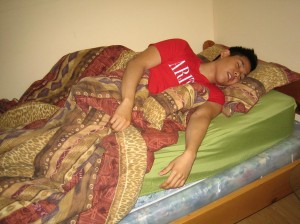Dust mite allergy is sensitivity or reaction to the miniature bugs found in household dust. It causes sneezing and runny nose. Some experience symptoms of asthma such as wheezing and breathing difficulties. Close relatives of dust mites are spiders and ticks.
[youtube url=”https://www.youtube.com/watch?v=L_JuVuespm4″]Dust mites eat dead skin cells shed by humans and live in warm and humid environments. They also like to live in beddings, upholstered furniture and carpeting. The symptoms become worse especially in the process of cleaning such as sweeping, vacuuming and dusting since it stirs up the dust particles and makes them easy to be inhaled.
Symptoms of dust mite allergy
- Itchy, red and watery eyes
- Running nose
- Coughing
- Postnasal drip
Difficulty in sleeping due to shortness of breath, coughing or wheezing - Nasal congestion
- Itchiness of the nose, roof of the mouth or throat
- Swelling and skin under the skin appears bluish
- Facial pressure and pain
- Frequently upward rubbing of the nose
- Chest pain or tightness
- Difficulty breathing
- Whistling or wheezing sound can be heard when exhaling
- Difficulty in sleeping due to shortness of breath, coughing or wheezing
- Coughing episodes or wheezing becomes worse due to the common cold or the flu.
Causes
House dust is usually found in fibers of bed lines, cushions of furniture and carpeting and they hold moisture. The bedroom is the best dwelling places for dust mites. Dust mites contain feces and their decaying bodies and proteins found in debris causes dust mite allergy.
Treatment
- Take the prescribed over-the-counter antihistamine to lessen the sneezing, itching and watery eyes.
- Cover the mattress as well as pillows using dust-proof covers. They are made of tightly woven fabric that prevents dust mites from multiplying or escaping from the bed or pillows.
- Wash beddings regularly such as blankets, sheets, pillowcases and bed covers using hot water at least 130 degrees F or 54.4 degrees C to eliminate dust mites and allergens. If they cannot be washed hot, put them in the dryer at least 15 minutes with temperature above 130 degrees F or 54.4 degrees C to eliminate the mites. Wash them to remove the allergens. Another option is freezing the items for at least 24 hours can also eliminate the dust mites, but allergens cannot be removed.
- Maintain humidity inside the house below 50%. Installing a dehumidifier or an air conditioner keeps the humidity low and a hygrometer measures the level of humidity.
- Use a damp mop or rag in cleaning up the dust to prevent it from being airborne and resettling.
- Clean and vacuum carpeting and upholstered furniture to eliminate any surface dust.
- Avoid using bedding that can trap dust easily and difficult to clean.
- Avoid eating in the bed or soft furnishings where house mites usually flourish.
- Take a bath or shower before going to bed at night.
- Avoid bringing animals inside the bedrooms to prevent dust mites and allergens.
